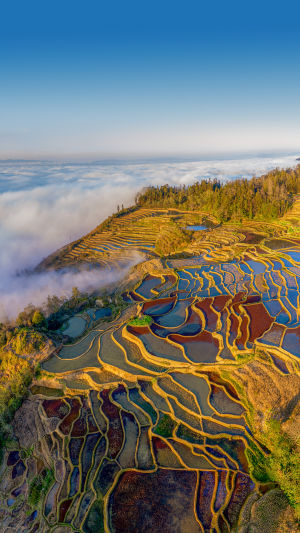Terraced fields, also known as step farms or rice terraces, are captivating agricultural landscapes that have been shaped by human hands for centuries. These remarkable agricultural systems, found in various parts of the world, are ingeniously designed to make the most of steep or hilly terrains
From the lush rice terraces of Southeast Asia to the awe-inspiring Andean terraces of South America, these man-made marvels combine functionality, beauty, and sustainability.
The concept of terraced fields originated thousands of years ago, with ancient civilizations realizing the need to optimize farming in challenging topographies. By creating leveled steps or platforms on sloping lands, they effectively controlled erosion, conserved water, and maximized arable land.
Terracing involves reshaping the land into a series of horizontal or gently sloping terraces, resembling steps carved into the landscape.
One of the most iconic examples of terraced fields can be found in the Philippines, particularly in the Cordillera region. The Banaue Rice Terraces, often referred to as the "Eighth Wonder of the World," stretch like ribbons across the mountainsides.
These terraces, hand-carved by the indigenous Ifugao people over 2,000 years ago, have not only provided sustenance for generations but also hold immense cultural significance.
Terraced fields offer a range of advantages for agricultural practices. The stepped layout helps prevent soil erosion by slowing down the flow of water and reducing the force of rain runoff. This is particularly crucial in mountainous regions where the risk of soil erosion is high.
The terraces act as mini-retention walls, trapping sediment and preventing it from being washed away, which helps to maintain fertile soil for cultivation.
Moreover, terraced fields facilitate effective water management. By creating flat or gently sloping platforms, farmers can construct small channels and reservoirs to collect and distribute water evenly across the terraces. This allows for efficient irrigation, reducing water wastage and increasing crop productivity.
Additionally, terraces help to prevent waterlogging in low-lying areas and allow excess water to drain effectively.
Terraced fields are not only functional but also visually striking. The symmetrical patterns created by the terraces transform hillsides into living works of art. The interplay of light and shadow across the stepped landscape adds to their allure.
In some regions, like the Yuanyang Rice Terraces in China, the terraced fields have become popular tourist attractions, attracting visitors from around the world who marvel at the intricate beauty of these man-made landscapes.
Beyond their agricultural and aesthetic value, terraced fields contribute to biodiversity conservation. The terraces create microhabitats with different moisture levels, allowing for the cultivation of various crops at different elevations. This diversification promotes ecological balance by supporting a wide range of plant and animal species.
The terraces also provide a habitat for birds, insects, and other wildlife, enriching the local ecosystem.
However, terraced fields face several challenges in the modern world. Changes in agricultural practices, urbanization, and shifting demographics have resulted in the abandonment of many terraced areas.
Younger generations often migrate to cities, leaving behind aging farmers who struggle to maintain and cultivate the terraces. As a result, many terraced landscapes are at risk of being lost forever, along with the traditional knowledge and cultural heritage associated with them.
To ensure the preservation and sustainability of terraced fields, efforts are being made to promote their value and importance. Organizations and local communities are working together to raise awareness, provide training and support to farmers, and develop sustainable tourism initiatives.
Recognizing the intrinsic worth of these agricultural wonders, there is a growing appreciation for the need to protect and celebrate terraced fields as invaluable cultural and environmental assets.
Terraced fields are remarkable agricultural systems that have shaped the landscape and supported communities for centuries. They demonstrate the ingenuity and resilience of human beings in adapting to challenging terrains.
With their ability to control erosion, optimize water management, and foster biodiversity, terraced fields represent a harmonious relationship between humans and nature. Preserving and cherishing these cultural landscapes is essential to safeguarding our heritage and ensuring a sustainable future for generations to come.





